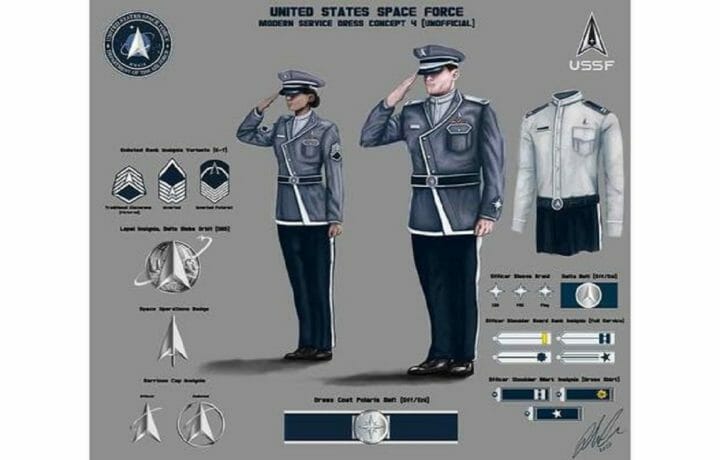Earlier this week, images circulated online allegedly depicting concepts for the Space Force dress uniform. Gray and blue, they looked like something otherwise found worn by the villains in the film Spaceballs, or the heroes in Starship Troopers. Neither comparison was particularly appealing for guardians (more on that word below), with the style of the former being intentionally ludicrous, and the latter being based on the uniforms of Nazi stormtroopers.
First, it’s important to know this: the uniform concept is not real, as Space Force representatives have confirmed. A member of the Space Force drew it and presented it to Reddit, with the internet game of telephone taking it from there, culminating in the Twitter outrage machine having a new place to vent its bile.
Look, the Space Force does have a problem. Because it has no existential urgency beyond “I dunno—we just wanted it now,” and because, unlike the Air Force in 1947, it has no distinct service culture, every decision its leaders make is going to get scrutinized into oblivion. Today’s choices will echo for centuries.
I’ll give the artist credit. He was being imaginative and thinking beyond the Air Force. The uniform was a swing and a miss, but it wasn’t a business suit with ribbon rack. As I have written here previously, the Space Force should use naval ranks and wear a Navy-inspired uniform. In the extreme long term, that’s what the branch will be. To use another sports metaphor, you don’t skate to where the hockey puck is. You skate to where it’s going to be.
WARRIOR CULTURE
Since we are paying attention to military uniforms again, I would be remiss if I did not take the opportunity to throw rocks at the increasingly ridiculous spectacle of the “pinks and greens” Army dress uniform, which is just peak Army: a uniform nobody wanted, to replace a uniform nobody wanted.
I’ve written at length about this here. Honestly, it’s one of my favorite things I’ve ever written, with this line I’d like carved on my gravestone: “This is the same Army who has been through three camouflage patterns so far in the same war. Grass, rocks, trees and sand have been the same for about 70 million years. It’s like the people who choose these patterns go outside, look at the forest, and say, ‘Well that looks nothing like the ACU pattern. What’s going on with these trees?’”
When it comes to duty uniforms, the Space Force early on demonstrated a small but real commitment to frugality by using the same operational camouflage pattern as the Army and Air Force. It feels strange to applaud the Defense Department for coming to a consensus on what nature looks like. Still, the Pentagon allowed the Navy to use a camouflage pattern the same color as rushing water—precisely the worst pattern imaginable if you fall overboard.
When it comes to sane military decisions, take the wins where you find them.
GUARDIANS OF THE SOLAR SYSTEM
December started with the Space Force settling on the name it will call its service members: Guardians. As in: People in the Army are soldiers. People in the Navy are sailors. People in the Air Force are airmen. People in the Marine Corps are confused. (What do you call a Marine with an IQ of 160? A platoon.) And people in the Space Force are guardians.
On first blush, I admit that this feels a little off, somehow. The word “soldier” has been around since the 1300s, so it gets a pass. A soldier is just… a soldier, a person who does soldiering. Sailors, airmen—those words are very modest and workmanlike, descriptive of the roles that service members perform. A person in the Navy sails on boats and a person in the Air Force keeps planes in the air, both in the same way that a fisherman catches fish or a mechanic works on machines.
Guardian is a bit… ostentatious. (It also complicates the inevitable ungendering of “guardsmen” in the National Guard.) But I admit, dear reader: I like “guardian.” (I want it lowercase, though. The capital-M Marine business is absurd enough. It’s a government job; let’s get a grip, shall we?) Still, there’s a lot to work with.
DEFINING A GUARDIAN
Identity matters, and in the military, it matters a lot. Rangers, Raiders, Sappers, Defenders, Sentinels, Scorpions, Ravens—there are a thousand such names across the service, and each in some way defines a military unit or skillset. Beyond that, the names imbue a certain esprit de corps.
For example: There is nothing inherently menacing about the word “ranger.” If anything, the word instills a sense of freedom and serenity. A ranger ranges—roams vast distances. It is a foundation, and on that simple word, Army Rangers have built a reputation as lethal, pitiless warriors with granite-like strength, indefatigability, and cool leadership under fire.
A guardian is peaceful, vigilant, ready. It is no more or less ridiculous a word than ranger. It’s a bedrock word—and a good one. Like ranger, what matters is what the Space Force does with it. What matters are the values the service branch embodies and expects of the men and women who wear its uniform—whatever that uniform might be.



